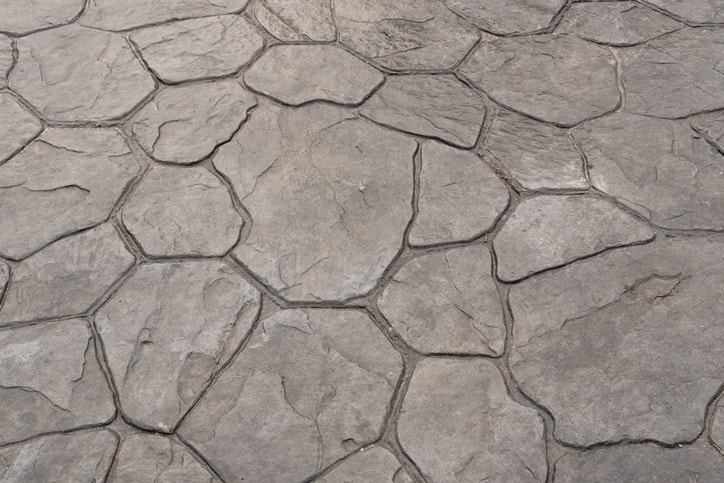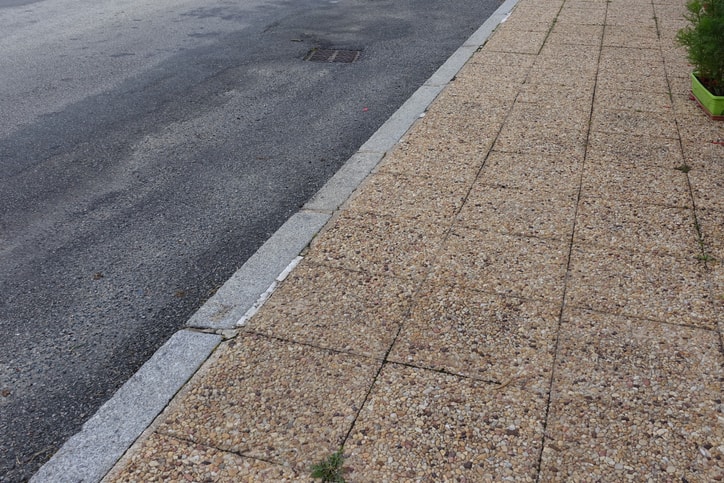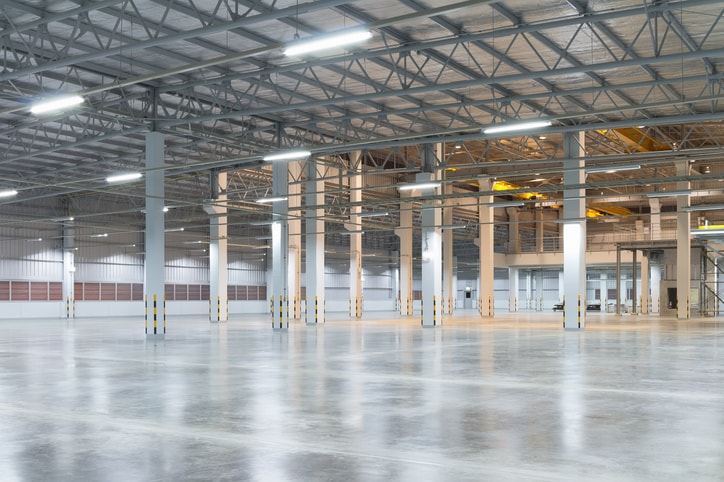
If you live in a regular suburb or a city, you likely see the results of thousands of hours of work from concrete contractors every single day. Most of them are probably sidewalks, driveways, streets, and even homes.
All of these pieces of concrete — including some architectural concrete — serve a particular function. Without concrete floors and other concrete surfaces, life would be very different.
With that being said, that doesn’t mean it all has to be boring, traditional gray concrete. There is a variety of decorative concrete options you can choose from. Not only will they serve the function you need, they’ll improve the overall look of your home.
Stamped Concrete
We did a whole article about stamped concrete that you can check out here. This type of concrete is a relatively inexpensive way to elevate the aesthetics of your home’s exterior.
Stamped concrete is basically regular concrete with added texture patterns. Our workers simply pour a concrete mixture, smooth it out, and then lay stamps onto the existing concrete.
These stamps are simply mats. They are flat on one side — where the workers will often stand — and on the other, there is an indentation that has specific textures and designs. They are made to resemble stone pavers, brick, and even wood.
Within those categories, there are many different textures you can choose from. Concrete contractors will often lay out a variety of textures on one concrete surface to give it a unique aesthetic.
Stamped concrete can be a great addition to different areas of your home including driveways, walkways, patios, and even pool decks.
Stenciled Concrete
Applying stenciled concrete is a similar process to stamped concrete. Instead of stamps, you overlay paper-like stencils over the top of concrete as it’s about to dry. Then at a certain point, you remove the stencil. It often gives the feeling of brick and mortar without any actual masonry.
Colored Concrete

A lot of the stamped concrete and stenciled concrete is also colored concrete. This is where we add either concrete stains and dyes, integral colors, or color hardeners to gray-colored concrete. You can get concrete in virtually any color you want.
Stained Concrete
The decorative concrete industry uses concrete stains that can be used for decorative concrete floors both inside and outside. They are also good for concrete countertops.
Concrete stains come in one of three different types:
- Acid stains use metallic salts to add color to your concrete. There are various ways to apply them, which can result in different designs. This type of stain is generally permanent, and it can elevate your home so you aren’t just looking at plain concrete floors.
- Water-based stains are generally considered more environmentally friendly than acid staining. They often mimic the appearance of acid based chemical stains, but they don’t feature the harmful effects. They come in a wide variety of colors. Some options are more solid while others are more transparent. It just depends on what you want.
- Stain sealers are a way to kill two birds with one stone. They color your concrete, but they also add extra protection to it.
Color Hardeners
Color hardeners are another way to add color to decorative concrete. These are generally done on outdoor projects, including stamped concrete.
Color hardeners are a powder that workers will place over wet concrete. You can get an interesting aesthetic, but color hardeners are difficult to get right.
Integral Colored Concrete
Integral color is what we tend to use at OKCrete on our stamped concrete. It is one of the easiest decorative concrete products to use. It comes in the form of a powder that you mix in before the pouring process.
This aesthetic enhancement gives your concrete a consistent look throughout. No matter what happens, your decorative concrete will stay that color, whether it’s freshly placed concrete or much older.
Exposed Aggregate

Most concrete slabs are made up of cement, water, and some kind of aggregate. Concrete is usually designed to hide that aggregate, so all you’re seeing is a plain white or gray surface.
Exposed aggregate takes a different approach to concrete. Instead of hiding it, this type of decorative concrete actively shows the aggregate, hence the name. You’ve likely seen this type of concrete without knowing it. It looks like regular concrete with a bunch of rocks molded into it.
The way we get this type of look is by taking out the top layer. There are several ways of doing this, but one of the easiest is by applying a retarder over the top after it’s been laid out and smoothed over with various concrete tools. Once it’s dry, you rinse the retarder off, and you have beautiful exposed aggregate.
Broomed Concrete

Broomed concrete is among the popular decorative concrete finishes. It’s created by having someone go over wet concrete with a broom while it’s waiting to dry.
The final result is concrete that has a rugged yet organized look. Not only can it provide a unique aesthetic, it adds traction so people are less likely to slip on it.
Polished Concrete

Polished concrete has a slick, reflective appearance to it. It’s smooth to the touch, and it can be slippery unless the people who laid it out take certain steps to prevent that. You’ve likely seen this type of decorative concrete on garage floors and in grocery stores.
The process of creating polished concrete involves using a chemical densifier, which fills in the pores of your concrete and hardens the entire surface. Once that’s dry, a worker pushes a grinder all along the surface. It’s kind of like sanding wood to make it smooth, but this time, it’s concrete.
Epoxy Floors

Epoxy floors have a similar appearance to polished concrete, but the process is a little different. It starts with grinding the floors, and then adding a few layers over the top, which can include a sealer, and one-to-two epoxy layers.
Epoxy floors are a little easier to maintain than polished concrete, and it may be a more cost effective option. You can also choose different colors and designs to make your concrete floors stick out.
Overlays On Top of Existing Concrete
In most of the examples above, we are assuming that you are laying out brand-new concrete. However, that doesn’t have to be the case. You may be able to lay out polymer cement overlays on top of the concrete that’s already there. From there, you can use stamps or stencils to get the look you want.
A polymer cement overlay is a little bit different from regular concrete. The polymer cement is a little more runny, and it often takes a little longer to get dry.
You wouldn’t necessarily want to do decorative overlays if your concrete is especially damaged. If that’s the case, you’ll probably want to redo the entire process. These kinds of overlays are best for concrete that’s already there, but you want to get a more elevated look without spending a ton of money.
Let OKCrete Help You Out
If you’re looking for a beautiful decorative concrete finish for your home, look no further than OKCrete.
We’ve been serving the great people in Oklahoma City and Tulsa for over a decade now. All of our workers are highly-skilled, experienced professionals who know how to provide quality work.
Not only that, we have a reputation of listening to our customers. If you have an idea for a project, we’ll hear your needs, give you a free quote, and start the project when you’re ready for us.
Click here to get started with OKCrete.
